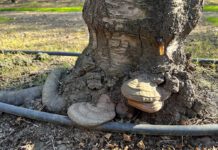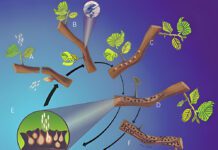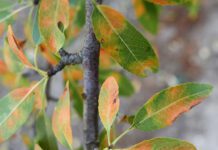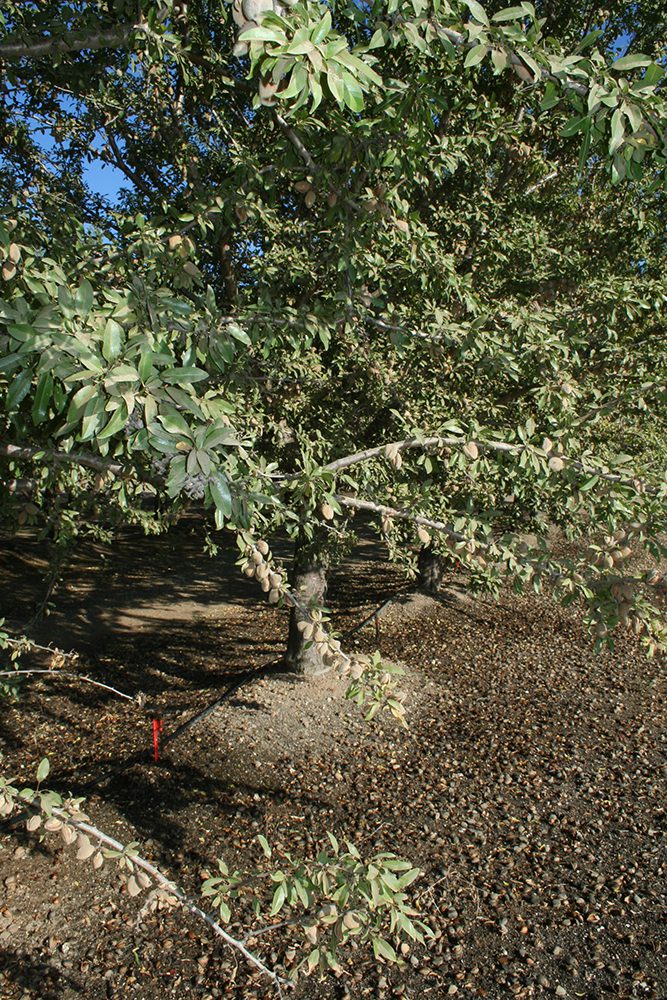
Summer foliar diseases cause defoliation of the trees and over time reduction in yield. Defoliation also leaves the trees vulnerable to other diseases.
Jim Adaskaveg, a professor and plant pathologist at UC Riverside, is doing research on Alternaria leaf spot and scab in almonds. A disease severity value (DSV) model has been developed for almond forecasting of Alternaria leaf spot, and Adaskaveg is currently developing a sporulation model for scab.
“Those are the main two summer diseases that cause defoliation in almonds year after year. So, with developing the models, we’re trying to determine the effects of wetness, relative humidity and the sporulation for the scab pathogen,” Adaskaveg said.
“We’re trying to develop a scab model to predict sporulation of the twig lesions that occur on the green shoots. And then we can time our sprays by when that model says these lesions should be sporulating, the primary inoculum for infecting new almond growth (i.e., leaves, shoots, and fruit) in the spring,” he explained.
This would allow growers to time their applications so they’re applied when needed, and it might also tell them they don’t need to spray at all, Adaskaveg said.
“If you don’t have the right weather, it won’t sporulate, so it’s really for the judicious timing of fungicide applications,” he said.
Adaskaveg is also doing fungicide applications and testing new products. “We’re constantly evaluating fungicides, and new fungicides that are becoming available as well as biologicals and biopesticides such as fermentation products that will be organically approved,” Adaskaveg said.
A product called natamycin was registered as a postharvest biopesticide, and last year, it received organic certification from Organic Materials Review Institute (OMRI). This year, Adaskaveg is testing it as a preharvest treatment, so it could be useful not only for summer foliar diseases, but for all foliar diseases of almond, including Alternaria leaf spot and scab.
Impacts of the Disease
Leaf defoliation from foliar diseases in almond can lead to sunburn which opens the trees to canker diseases.
“It also affects yield because there are only so many buds on a tree, and if the tree loses its leaves, it has to re-foliate first just for survival. And that means there would be less buds to form flowers next year,” Adaskaveg said. “Yields go down in the subsequent years, so it’s both direct effects and indirect effects on the tree health.”
The fungal pathogens, Alternaria spp, are ubiquitous, so it is almost always in the air because it can be found on a number of plants and organic material, whereas the scab pathogen only infects almond and other Prunus spp. If just one scab twig infection occurs on the stem, it carries over from one year to the next, Adaskaveg said.
Chemical Treatments
Adaskaveg is always being asked why so many chemicals are needed to treat foliar diseases. “The more you have is actually better because it allows for competition, it allows for rotation to prevent resistance, there’s more people using different treatments, and there’s less contamination of any one compound,” he said.
Rotating and not using one material over and over means growers have lots of materials to choose from and keeps resistance from building.
“Most growers want to be good stewards of the land, and this helps them achieve that,” Adaskaveg said.
Adaskaveg will continue to evaluate new products. “The idea is you have to stay ahead, and you have to know what’s going on, so you have to have trials, and we move these trials around to different locations where there are problems,” he said.
Adaskaveg works with commercial growers on university property, and he tests registered and non-registered materials that are already registered on other crops. He also tests experimental materials on university property.
“We have all these different stages of development and evaluation, like a continuum, from very early stages to things that are already registered on other crops, but we want to get them registered on almonds. And then we have things that are already registered on almonds, and we test how well they’re continuing to perform,” Adaskaveg said.
“That’s the idea behind having someone like me doing that type of work is to ensure that we have a continuous pipeline, if you will, of materials,” Adaskaveg said.
Environment and Disease
Problems with these diseases vary because orchards vary from planting density to orientation of the rows to the configuration of how the orchard is planted and arranged, Adaskaveg said.
“The tree density, for example, if it’s arranged north/south or east/west, affects the microclimates within the orchard,” he said.
Generally, in areas where there’s more rain like in the north part of the state, the disease is usually more severe. Irrigation is also a contributing factor, and depending on irrigation sets and availability of water, it could create environments favorable for disease.
“If growers have to use long irrigation sets, or if there was more rain in certain regions, then that sets them up for having more disease problems,” Adaskaveg said.
“The north gets usually more rain, so in general, the north has more foliar diseases,” he said, but in Kern County, where high-density, high-input orchards were planted in low areas, such as lake beds, and areas with high moisture, they can also have higher disease problems.
“They can also be created by nature with heavy rainfall that’s very conducive for foliar diseases,” Adaskaveg said.
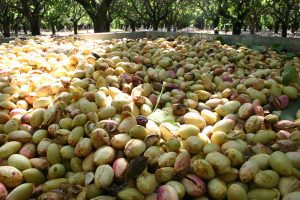
Alternaria in Pistachio
Ongoing research is being conducted on pistachios by Themis Michailides, a plant pathologist at UC Davis and Kearney Agricultural Research and Extension Center, and Boris Camiletti, postdoc researcher with UC Davis in the plant pathology department. The project has been underway for several years, and Camiletti started working on it in July 2020.
“We have different projects with pistachios. One is focused on managing Alternaria late blight in the field. We are working with fungicide resistance as well,” Camiletti said.
The crux of the research is testing chemical treatments for Alternaria late blight, he continued. As part of this project, samples are taken every year from orchards throughout California to determine the resistance levels to strobilurins and carboxamides. Camiletti encourages growers to send leaf samples with Alternaria lesions at the end of the season to help determine the resistance levels in the pistachio orchards. Samples can be sent to Dr. Boris Camiletti at UC Kearney Agricultural Research and Extension Center, 9240 S. Riverbend Ave., Parlier, CA 93648-9774.
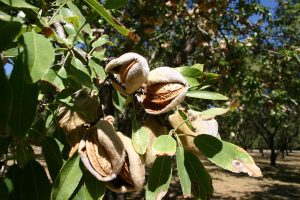
“This would help us collect the samples that we need for our project more easily, and the growers will know the resistance levels in their orchards,” Camiletti said.
“We test traditional chemicals and new ones. We are also testing from different chemical classes. Every new product, we try to test it,” Camiletti said.
This is important research because the efficacy of the commercial products is threatened by resistance. “Every year, Themis and I test several commercial products to corroborate that efficacy is still there. Some products may have problems with resistance, but they are still effective,” Camiletti said.
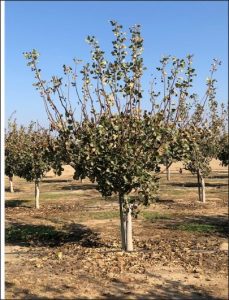
Another research project is creating models to predict disease in the field because in some orchards the disease is very variable. This will give growers the ability to determine the level of disease in their orchards, Camiletti said.
“We will have some molecular protocols this year that private laboratories can use to quantify the resistance levels in the orchards,” Camiletti said.
Currently, they have only just started testing the models. They were tested in the past, but on an experimental scale, and now they’re testing these models at commercial scale, and that project will end December 2024, Camiletti said, adding the website will be up and running later in 2023.
Once it’s ready, it will allow the grower to enter information on a specific orchard to predict when fungicide sprays have to be applied to control the disease. “We will also organize a workshop to train them how to use it,” Camiletti said.
Impacts of the Disease
Alternaria in pistachios causes different problems from defoliation to yield loss to tree health. “I think the most important problem is the shell stain that affects the quality of the nuts and therefore generates economic losses for the growers. We don’t have an estimation, but talking with processing plants, it can be around $2,000 an acre in some cases if the disease is not controlled,” Camiletti said.
“Alternaria is a pathogen that depends a lot on the humidity in the orchard. For example, there are orchards that are next to a river or other water reservoirs that have the disease every year, so growers are applying fungicides every year because they have problems with the disease from the humidity,” Camiletti said.
Other orchards, the disease might be very sporadic, so sprays may not be performed when needed and then the disease develops. To manage the disease, growers should apply fungicides June to July to control it, but symptoms may not develop until much later in the season (August to September). If they didn’t spray, it is too late when they see the symptoms. This is what we are trying to solve with the models,” Camiletti explained.
Humidity comes from irrigation in the orchard. Irrigation is generally at night and water on the ground will remain in the orchard and create leaf wetness, leaving the orchard susceptible to the disease, Camiletti said.







